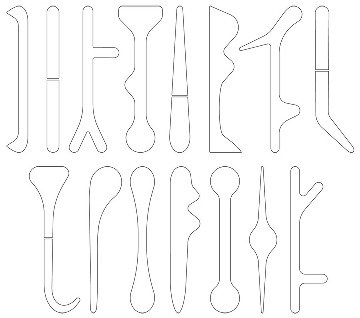Michael Heizer
dal 8/5/2015 al 1/7/2015
Segnalato da
8/5/2015
Michael Heizer
Gagosian Gallery, New York
Altars. The artist's exhibition with the gallery comprises rarely or never-before-seen early paintings, the Altar series of new monumental steel sculptures, and negative wall sculptures featuring metamorphic and igneous rocks.

Gagosian New York is pleased to present the work of legendary sculptor Michael Heizer. Heizer's first exhibition with the gallery comprises rarely or never-before-seen early paintings, the Altar series of new monumental steel sculptures, and negative wall sculptures featuring metamorphic and igneous rocks.
Working largely outside the confines of gallery and museum, Heizer has redefined sculpture in terms of size, mass, gesture, and process. In the late 1960s, he relocated to New York, while continuing to travel and live in the open terrain of the American West, where he has since created awe-inspiring land artworks. Heizer draws on both ancient and contemporary architecture and art, cultivating tons of materials, including dirt, rock, and steel, in his quest to create a “permanent American art.” These influences are present in City, the vast land sculpture in Nevada that he has been building continuously since 1972. North, East, South, West, which he first executed in the Sierra Nevada mountains in 1967 and finally resolved at Dia:Beacon in 2002, comprises four geometric depressions, each sinking twenty feet below the ground. Double Negative (1969–70), a pair of cuts fifty feet deep in facing cliff edges of Mormon Mesa in Nevada, was made by displacing 240,000 tons of sandstone and rhyolite.
The shaped canvases from the 1960s and 1970s demonstrate Heizer's early exploration of positive and negative forms; such harmonies of presence and absence, matter and space, are essential to his art. In Trapezoid Painting (1966) and Track Painting (1967), he emphasizes the perimeters of raw canvases by painting them black, while the white interiors are perceived as negative spaces. These hard-edged “displacement paintings” parallel the immense geometries he achieves when moving earth. The slate grey contours of U Painting (1975), for example, anticipate the shapes of the depressions and angular mounds later created in City.
In works that he describes as “negative wall sculptures,” Heizer harnesses the beauty and bulk of rock and mineral specimens: the 10 × 12 inch Blue Diorite (1981) that sits 14 inches deep into a wall; Asteroid (c. 2000), a cinnamon-hued 12-ton ore rock; and Potato Chip (2015), an 18-ton granite monolith. Such sculptures find their origins in Displaced Replaced Mass (1969), the artist's first negative sculpture, which was prompted by his desire to “create an absence and then refill the same void.” Here, the rocks are edged into rectangular cavities cut into the gallery walls, creating a tension between viewer, nature, and architecture that Heizer epitomized with Levitated Mass, the granite megalith perched above a sloping concrete trench through which viewers pass, on permanent view at LACMA since 2012.
Altar 1, Altar 2, and Altar 3 (all 2015) are tiered steel platforms measuring up to 40 feet by 40 feet, each of which presents curvilinear coated steel elements that lean dynamically and at contrasting angles. Echoing the Chaotic Geometric Sculptures of the late 1980s, many of Heizer's latest sculptures are delineated by taped and stenciled lines around their perimeters; the surfaces are grounds for silkscreened, fragmented black and white images derived from the artist's photographs and drawings. The massive forms—which he conceived three decades ago and only recently completed at this scale—are inspired by a range of pictographic influences, from ancient rock carvings to the cryptic icons of cattle-branding. By unifying the images and architecture of different cultures and eras, Heizer strives to create a resonant art for a pluralistic world.
A fully illustrated catalogue with an essay by curator and art historian Ruth Fine and a conversation between Heizer and Gagosian director Kara Vander Weg is forthcoming.
Michael Heizer was born in Berkeley, California in 1944, and lives and works in Garden Valley, Nevada. His work has been collected and exhibited by Museum of Modern Art, New York; Whitney Museum of American Art, New York; Dia:Beacon, New York; Metropolitan Museum of Art, New York; Los Angeles County Museum of Art; Museum of Contemporary Art, Los Angeles; Fondazione Prada, Milan, and many other institutions worldwide. Solo museum exhibitions include Detroit Institute of Arts (1971); Museum Folkwang, Essen, Germany (1979, traveled to Rijksmuseum Kröller-Müller, Otterlo, The Netherlands); St. Louis Art Museum (1980); Museum of Contemporary Art, Los Angeles (1984); Whitney Museum of American Art, New York (1985); and Fondazione Prada, Milan (1996). Permanent, site-specific sculptures include Adjacent, Against, Upon (1976, Myrtle Edwards Park, Seattle); Levitated Mass (1982, 590 Madison Avenue, New York); 45°, 90°, 180° (1984, Rice University, Houston); North, East, South, West (1967/2002, Dia:Beacon, New York); Levitated Mass (2012, Los Angeles County Museum of Art); and four major sculptures at the Menil Collection, Houston. Double Negative (1969), a site-specific land work, remains on permanent public view in the Mormon Mesa near Overton, Nevada.
Image: invitation
Press Contact:
Contact: Andy Ptaschinski
E. andy@bluemedium.com
Opening: Saturday, May 9th, from 6:00 to 8:00pm
Gagosian Gallery
555 West 24th Street
New York, NY 10011



